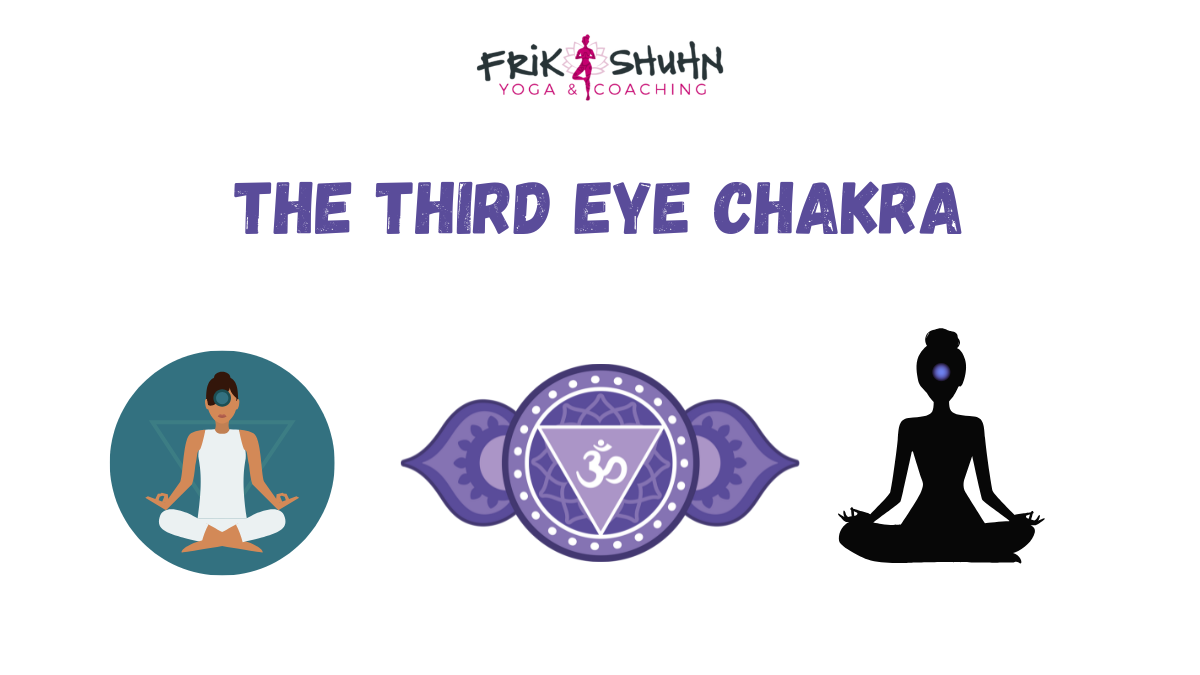Third Eye Chakra: Perception, Intuition & the Brain

Discover the third eye chakra as clarity and focus. Learn yoga and somatic practices that enhance intuition, vision, and nervous system balance.
👁️ Third Eye Chakra: Perception, Intuition & the Brain
Have you ever had a gut feeling that turned out to be right? Or suddenly seen a situation with such clarity that everything clicked into place? Those moments belong to the Third Eye Chakra (Ajna) — the seat of perception, intuition, and insight.
Located between the eyebrows, Ajna is the sixth chakra in the yogic system. It governs vision beyond the eyes — the ability to perceive truth, to discern patterns, and to trust inner knowing. In yogic philosophy, it’s the command center where wisdom and intuition meet.
In modern science, this region corresponds to the pituitary gland, prefrontal cortex, and visual processing centers of the brain. It is quite literally where we integrate sensory data and create meaning.
When Ajna is balanced, we experience clarity, intuition, and focus. When blocked, we may feel confused, indecisive, or disconnected from our inner wisdom. When overactive, we might get lost in fantasy or overthinking.
This blog explores how the third eye chakra bridges yogic philosophy and neuroscience, how somatic practices sharpen perception, and how teachers can help students develop embodied insight.
Yoga Meets Science: Ajna as the Command Center
The Sanskrit word Ajna means “to perceive” or “to command.” Yogic texts describe it as the center of intuition and wisdom, associated with the color indigo and the element of light.
Science provides fascinating parallels:
-
Pituitary Gland: Known as the “master gland,” it regulates hormones that affect growth, metabolism, and reproductive systems.
-
Prefrontal Cortex: The part of the brain linked with focus, decision-making, and pattern recognition.
-
Neuroplasticity: Meditation, often practiced to “open the third eye,” has been shown to rewire neural pathways, enhancing clarity and emotional regulation.
In other words, Ajna represents not only mystical insight but also biological integration. It’s where data becomes discernment and intuition becomes embodied intelligence.
The Somatic Lens: Seeing Within
Somatically, the third eye chakra is about perception. While not physically located in the hips or chest like other chakras, it’s deeply felt in the nervous system. Signs of imbalance include:
-
Headaches or tension around the forehead and eyes
-
Difficulty focusing or making decisions
-
Over-reliance on external validation
-
Distrust of intuition or inner knowing
When Ajna is balanced, the mind feels calm but alert, focus sharpens, and insight flows naturally.
The somatic question becomes: What happens in my body when I trust my inner knowing? Where do I tighten when I doubt?
Practices & Examples: Awakening Ajna
Here are ways to bring awareness to the third eye chakra:
Asana
-
Child’s Pose (Balasana): Forehead to ground stimulates third eye point.
-
Eagle Pose (Garudasana): Enhances focus and balance.
-
Forward Folds: Allow inward turning for reflection and insight.
Breathwork & Meditation
-
Alternate Nostril Breathing (Nadi Shodhana): Balances hemispheres of brain.
-
Trataka (Candle Gazing): Concentration practice to sharpen vision and focus.
-
Meditation on Third Eye: Eyes closed, gaze slightly upward, noticing inner light.
Somatic Practices
-
Soft Gaze (Drishti): Relaxed eye focus that calms the nervous system.
-
Body Scan with Focus: Bringing awareness to sensations as a form of perception training.
Journaling Prompts
-
“When have I trusted my intuition and been right?”
-
“What practices help me feel clear and centered?”
-
“Where do I confuse overthinking with insight?”
Transformation & Teaching
For yoga teachers, Ajna is where you move students beyond physical postures into deeper awareness. You’re not just teaching them to balance in Eagle Pose; you’re guiding them into focus and presence.
You might say: “As your forehead rests on the mat, imagine tuning into your inner wisdom. Trust what arises here.” Or during meditation: “Bring your attention between your eyebrows, and notice any sensations of clarity or calm.”
This is where yoga shifts from exercise to self-inquiry. By teaching from Ajna, you help students strengthen both intuition and neurobiological clarity.
Why Third Eye Work Matters Now
We live in an age of information overload. The challenge isn’t access to knowledge but the ability to discern truth. Ajna practices are medicine for this — they sharpen focus, clear the noise, and reconnect us to inner guidance.
Science supports this. Meditation increases activity in the prefrontal cortex and improves decision-making. Breathwork balances hemispheric brain activity. Yogis have been practicing these methods for millennia; neuroscience now shows us how they work.
Ajna, then, is not just mystical — it’s practical. It’s about cultivating clarity in a world that thrives on distraction.
Ready to strengthen your inner vision and bring clarity into your teaching? Here are three ways forward:
✨ Access the Awakening the Chakras YTT online inside my Experiential Teacher Path subscription. For $297/month, you’ll gain this training plus every other YTT I offer, all counting toward your 300-hour certification: Join Here
✨ Download the Free Chakra PDF for a yoga-and-science guide to all seven chakras: Get the PDF
✨ Immerse yourself at the 50-Hour Chakra Teacher Training at Anamaya in Costa Rica. Explore Ajna through somatic practices in paradise: Learn More
Final Reflection
The Third Eye Chakra teaches us that perception isn’t just seeing — it’s understanding. It’s not about mystical visions but about clarity, discernment, and trust in our embodied wisdom.
Yoga says Ajna is the seat of intuition. Science shows us it’s also the prefrontal cortex, the pituitary gland, and the neuroplastic brain. Together, they remind us that insight is both spiritual and biological.
When we awaken the third eye, we awaken our ability to live with clarity in a world of noise. And when we teach from this place, we help our students find not just balance in their bodies, but alignment in their lives.
 Colynn Vosburgh
Colynn Vosburgh 